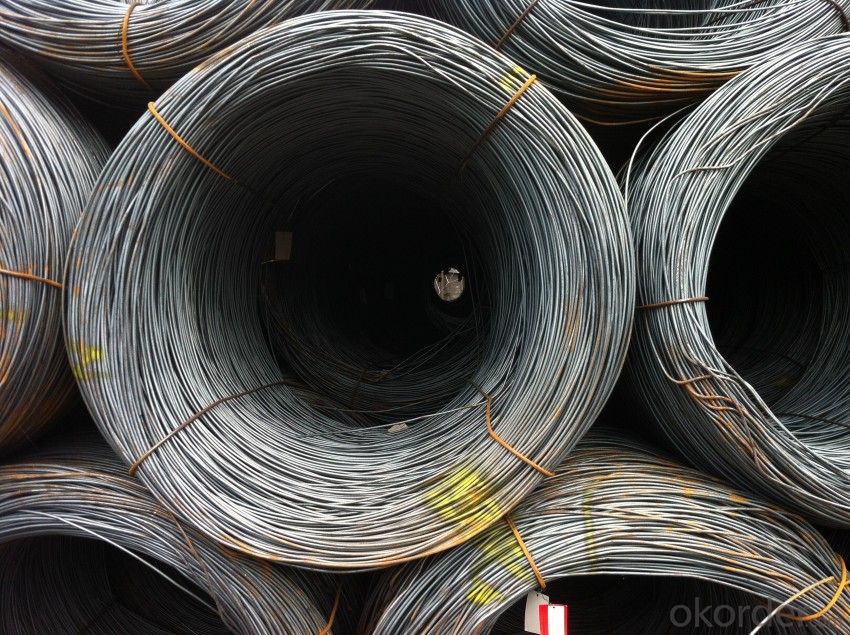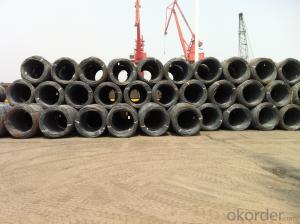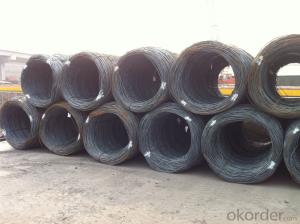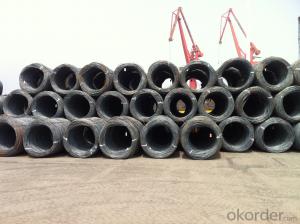Wire rod SAE 1006-1018 with Best Quality and Lowest Price
- Loading Port:
- Tianjin
- Payment Terms:
- TT OR LC
- Min Order Qty:
- 25 m.t
- Supply Capability:
- 20000 m.t/month
OKorder Service Pledge
OKorder Financial Service
You Might Also Like
Item specifice
OKorder is offering Hot Rolled Carbon Steel Wire Rod 5.5mm with High Quality at great prices with worldwide shipping. Our supplier is a world-class manufacturer of steel, with our products utilized the world over. OKorder annually supplies products to European, North American and Asian markets. We provide quotations within 24 hours of receiving an inquiry and guarantee competitive prices.
Product Applications:
Hot Rolled Carbon Steel Wire Rod 5.5mm with High Quality is widely used in construction and manufacturing. Carbon steel wire rod is mainly used for reinforcement of reinforced concrete and welded structure or reprocessed (roberts , nail, etc.) materials, especially used to produce wire drawing, welding electrode, nails, spring, electronic, precise machinery parts and so on.
Product Advantages:
OKorder's Hot Rolled Carbon Steel Wire Rod are durable, strong.packed and suitable for wire mesh,nail manufacture and construction
Main Product Features:
· Premium quality
· Prompt delivery & seaworthy packing (30 days after receiving deposit)
· Can be recycled and reused
· Mill test certification
· Professional Service
· Competitive pricing
Product Specifications:
Manufacture: Hot rolled
Grade: SAE1006 SAE1008 SAE1010 SAE1012 SAE1016 SAE1018
Certificates: ISO, SGS, BV, CIQ
Weight per Coil:2-2.05tons
Packaging: Export packing, packed by coil
Grade | Chemical Composition (%) | |||||
C | Mn | S | P | Si | B | |
SAE1006B | 0.03~O.07 | 0.32max | 0.045max | 0.040max | 0.30max | 0.0008min |
Mechanical properties | ||||||
Yield strength(N/mm2) | Tensile strength(N/mm2) | Elongation (%) | ||||
250-280 | 350-380 | ≥32 | ||||
Grade | Chemical Composition (%) | |||||
C | Mn | S | P | Si | B | |
SAE1008B | 0.10max | 0.3~0.50 | 0.050max | 0.040 max | 0.15max | 0.0008 min |
Mechanical properties | ||||||
Yield strength(N/mm2) | Tensile strength(N/mm2) | Elongation (%) | ||||
≥195 | 315-430 | ≥30 | ||||
FAQ:
Q1: Why buy Materials & Equipment from OKorder.com?
A1: All products offered byOKorder.com are carefully selected from China's most reliable manufacturing enterprises. Through its ISO certifications, OKorder.com adheres to the highest standards and a commitment to supply chain safety and customer satisfaction.
Q2: How do we guarantee the quality of our products?
A2: We have established an advanced quality management system which conducts strict quality tests at every step, from raw materials to the final product. At the same time, we provide extensive follow-up service assurances as required.
Q3: How soon we can delivery the goods ?
A3: We have a mill with 20000mts of capacity per month. We can delivery the goods within in one month ,as long as your order quantity less than 20000mts
Q4:What's your payment terms ?
A4:Mostly,we collect the money by T/T and LC at sight . We also accept time LC at 90/120 days sight.
Image:


- Q:How is steel wire rod used in the manufacturing of wire baskets and containers?
- Steel wire rod is an essential material in the manufacturing of wire baskets and containers. It serves as the primary component from which these products are constructed. The wire rod is typically made from high-quality steel and comes in various diameters, depending on the specific application and strength requirements of the wire baskets and containers. To create wire baskets and containers, the steel wire rod undergoes several manufacturing processes. First, it is drawn through a series of dies to reduce its diameter and increase its length. This process, known as wire drawing, helps to refine the wire rod and improve its tensile strength. After wire drawing, the steel wire rod is typically straightened and cut into specific lengths, depending on the desired size of the wire baskets and containers. It is then bent, twisted, or welded into the desired shape and structure, using specialized machinery and techniques. The steel wire rod's high strength and durability make it an ideal material for manufacturing wire baskets and containers. These products require sturdy construction to withstand heavy loads and resist bending or deformation. Steel wire rod provides the necessary strength and rigidity, ensuring that wire baskets and containers can safely hold and transport various items. Furthermore, the properties of steel wire rod make it highly resistant to corrosion and wear, ensuring the longevity of wire baskets and containers, even in harsh environments. This is particularly important for applications such as storage or transportation of goods in industries like agriculture, manufacturing, or logistics. In addition to its structural properties, steel wire rod also offers versatility in design. It can be easily manipulated into different shapes and sizes, allowing manufacturers to create wire baskets and containers that meet specific customer requirements. Whether it's a simple open-top basket or a complex container with dividers and handles, steel wire rod can be customized to suit various needs. Overall, the use of steel wire rod in the manufacturing of wire baskets and containers is crucial for ensuring the strength, durability, and functionality of these products. Its exceptional properties provide the necessary support and resistance to meet the demands of various industries, making steel wire rod an integral component in their production.
- Q:How is steel wire rod used in the manufacturing of wire for shipbuilding applications?
- The manufacturing of wire for shipbuilding heavily relies on steel wire rod due to its superior strength and durability. To begin the process, high-quality steel wire rod is carefully selected as the raw material. Thorough inspection and testing are conducted on the steel wire rod to ensure it meets industry standards for strength, corrosion resistance, and other essential properties. Once it passes these tests, the wire rod proceeds to the wire drawing process. During the wire drawing process, the steel wire rod is repeatedly pulled through dies to decrease its diameter and increase its length. This procedure is repeated until the desired diameter and length of the wire are achieved. Additionally, the wire drawing process enhances the wire's strength and surface quality, making it ideal for shipbuilding applications that require high tensile strength and corrosion resistance. Following the wire drawing process, the wire often undergoes additional treatments, such as annealing or heat treatment, to further enhance its mechanical properties. These treatments improve the wire's strength, ductility, and resistance to fatigue, ensuring it can withstand the demanding conditions encountered in shipbuilding. Once the wire has been processed and treated, it is wound onto large reels or coils for easy handling during the shipbuilding process. The wire is then utilized in various shipbuilding applications, including structural supports, cables, rigging, and other critical components that demand exceptional strength and durability. In summary, steel wire rod is of utmost importance in the manufacturing of wire for shipbuilding. Its ability to provide the necessary strength, durability, and corrosion resistance required in marine environments makes it an indispensable material in constructing ships capable of withstanding the challenges of the sea.
- Q:What are the different types of steel wire rod surface defect classification and grading systems?
- There are several types of steel wire rod surface defect classification and grading systems used in the industry. Some common ones include the ASTM E45 standard, which classifies defects based on their size and severity, and the ISO 4962 standard, which further categorizes defects into specific types such as cracks, scales, and pits. Additionally, some companies may have their own internal systems tailored to their specific production processes and quality requirements.
- Q:How is steel wire rod used in the manufacturing of wire forms for conveyor systems?
- Steel wire rod is used in the manufacturing of wire forms for conveyor systems by being shaped, cut, and bent into various forms such as hooks, rings, and clips. These wire forms are then integrated into the conveyor system to provide support, stability, and control for the movement of materials or products along the system. The high strength and durability of steel wire rod make it an ideal material choice for wire forms in conveyor systems, ensuring reliable and efficient operation.
- Q:How is steel wire rod used in manufacturing?
- Steel wire rod is used in manufacturing for a variety of purposes. It is commonly used as a raw material in the production of wire products such as nails, screws, springs, and cables. Additionally, it can be used in the construction industry for reinforcing concrete structures, as well as in the automotive industry for making various components. The versatility and strength of steel wire rod make it an essential material in many manufacturing processes.
- Q:What are the common alloying elements added to steel wire rod?
- The common alloying elements added to steel wire rod include carbon, manganese, silicon, and sometimes other elements such as chromium, nickel, and molybdenum.
- Q:What are the different types of steel wire rod coatings used for improved adhesion?
- There are several types of steel wire rod coatings used for improved adhesion, including zinc coatings, polymer coatings, and galvanized coatings. Zinc coatings, such as hot-dip galvanizing, provide excellent corrosion resistance and adhesion. Polymer coatings, like epoxy or polyethylene, offer enhanced adhesion and impact resistance. Galvanized coatings, which combine zinc with other metals like aluminum or nickel, provide both corrosion protection and improved adhesion. These different types of coatings are used to enhance the performance and durability of steel wire rods in various industries.
- Q:What are the common mechanical properties of steel wire rod?
- The common mechanical properties of steel wire rod include tensile strength, yield strength, elongation, and hardness. Tensile strength refers to the maximum amount of stress a material can withstand before it breaks or fails. Steel wire rod typically has high tensile strength, making it suitable for applications that require strong and durable materials. Yield strength, on the other hand, is the amount of stress a material can withstand before it starts to deform permanently. It is an important property to consider in applications where the material will be subjected to repeated loads or stress cycles. Steel wire rod often exhibits a high yield strength, allowing it to resist deformation under heavy loads. Elongation is a measure of how much a material can stretch or deform before it breaks. Steel wire rod commonly displays a moderate to high elongation, making it suitable for applications that require flexibility and the ability to withstand deformation without fracturing. Hardness is a measure of a material's resistance to indentation or scratching. Steel wire rod can have varying degrees of hardness, depending on the specific alloy and heat treatment. Higher hardness values can provide better resistance to wear and abrasion, making steel wire rod suitable for applications that require durability and resistance to surface damage. Overall, the common mechanical properties of steel wire rod make it a versatile material that can be used in a wide range of applications, including construction, automotive, manufacturing, and telecommunications industries.
- Q:What are the different types of steel wire rod surface defects and their impact on product safety?
- There are several different types of steel wire rod surface defects that can occur during the manufacturing process. These defects can have varying impacts on the safety of the final product. Some of the common types of surface defects include: 1. Scale: Scale is a layer of iron oxide that forms on the surface of the wire rod during the heating and cooling processes. It can impact product safety by reducing the wire's ability to adhere to coatings or causing surface irregularities, which can lead to poor performance or failure in applications. 2. Cracks: Cracks can occur due to various factors, such as improper cooling or excessive rolling. They can weaken the wire rod and compromise its structural integrity, making it more prone to breakage or failure under stress. This can be hazardous in applications where the wire is subjected to high loads or tension. 3. Pitting: Pitting is the formation of small cavities or depressions on the surface of the wire rod. It can occur due to corrosion or improper handling. Pitting can reduce the wire's resistance to further corrosion, leading to premature failure and potential safety hazards in applications exposed to corrosive environments. 4. Surface scratches: Scratches are superficial marks on the wire rod's surface, which can occur during handling or transportation. While minor scratches may not impact product safety significantly, deep or extensive scratches can create stress concentration points, reducing the wire's strength and potentially leading to failure in critical applications. 5. Surface contamination: Contamination can occur when foreign particles, such as dirt, oil, or other materials, adhere to the wire rod's surface. This can impact product safety by interfering with the wire's ability to achieve proper adhesion in coatings or impairing its electrical conductivity or mechanical properties. The impact of these surface defects on product safety depends on the specific application of the wire rod. In safety-critical industries like automotive or aerospace, even minor defects can compromise the integrity of the final product, leading to catastrophic failure. In contrast, for less demanding applications, certain defects may be more tolerable, as long as they do not compromise the wire's basic functionality. To ensure product safety, manufacturers employ various quality control measures to detect and minimize these surface defects. These measures can include visual inspections, non-destructive testing, and quality assurance processes throughout the production cycle. It is crucial for manufacturers and end-users to understand the specific requirements and potential hazards associated with different surface defects, and ensure appropriate quality standards are followed to mitigate any safety risks.
- Q:How is steel wire rod used in the manufacturing of suspension wires for bridges?
- Steel wire rod is used in the manufacturing of suspension wires for bridges as it provides high strength and durability. The wire rod is first processed through various stages such as drawing, annealing, and galvanizing to enhance its properties. These processed wire rods are then further formed into suspension wires, which are used to support and stabilize the bridge structure. The strong and flexible nature of steel wire rod ensures that suspension wires can withstand heavy loads and vibrations, making it an essential component in bridge construction for maintaining structural integrity and ensuring safety.
1. Manufacturer Overview |
|
|---|---|
| Location | |
| Year Established | |
| Annual Output Value | |
| Main Markets | |
| Company Certifications | |
2. Manufacturer Certificates |
|
|---|---|
| a) Certification Name | |
| Range | |
| Reference | |
| Validity Period | |
3. Manufacturer Capability |
|
|---|---|
| a)Trade Capacity | |
| Nearest Port | |
| Export Percentage | |
| No.of Employees in Trade Department | |
| Language Spoken: | |
| b)Factory Information | |
| Factory Size: | |
| No. of Production Lines | |
| Contract Manufacturing | |
| Product Price Range | |
Send your message to us
Wire rod SAE 1006-1018 with Best Quality and Lowest Price
- Loading Port:
- Tianjin
- Payment Terms:
- TT OR LC
- Min Order Qty:
- 25 m.t
- Supply Capability:
- 20000 m.t/month
OKorder Service Pledge
OKorder Financial Service
Similar products
New products
Hot products
Related keywords




























